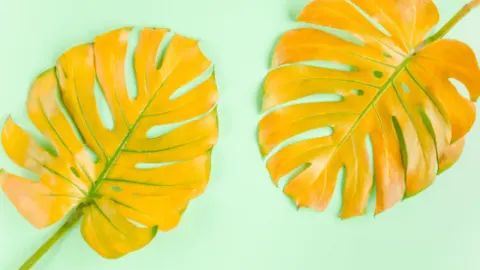Yellow leaves on plants are one of the most common plant problems. Yellow leaves indicate your plant is distressed and needs extra care.
If you gave me a dollar for each yellow leaf I had on my plants, I would be a millionaire. At least I now have great examples to show you and can talk about the causes, remedies, and potential solutions to avoid yellow leaves.

Takeaways
| Yellow Leaves on Plants | Identification, Causes and Remedies |
|---|---|
| Moisture Stress | Overwatering or underwatering can lead to yellow leaves. Check watering habits and adjust accordingly. |
| Light Issues | Insufficient sunlight or excessive light can cause yellow leaves. Reposition plants for proper lighting. |
| Temperature Stress | Extremely high or low temperatures can result in yellowing leaves. Protect plants from drafts and temperature fluctuations. |
| Nutrient Deficiencies | Lack of essential nutrients can cause yellow leaves. Identify nutrient deficiencies and address them with appropriate treatments. |
| Diseases | Diseases and fungi can lead to yellow or discolored leaves. Proper diagnosis and treatment are important. |
| Pests | Sucking insects like aphids, whiteflies, and spider mites can cause yellow leaves. Use organic insecticides to control pests. |
| Transplant Shock | Newly transplanted plants can experience yellowing due to stress. Proper care and gradual transition can help prevent transplant shock. |
| Chemical Burn | Incorrect or excessive application of chemicals can lead to yellow leaves. Follow instructions and precautions when using pesticides. |
| Fertilizer Burn | Excessive fertilizer use can result in yellowing and leaf scorch. Use balanced fertilizers and follow recommended feeding rates. |
| Aging Leaves | Natural leaf aging can cause yellowing of lower leaves. This is a normal part of the plant’s life cycle. |
Yellow Leaves on Plants
The most common reasons for yellow leaves on plants are overwatering, underwatering, light issues, plant pests, diseases, nutrient deficiencies, transplant shock, chemical burn, fertilizer burn, the wrong soil, or a natural cause due to aging.
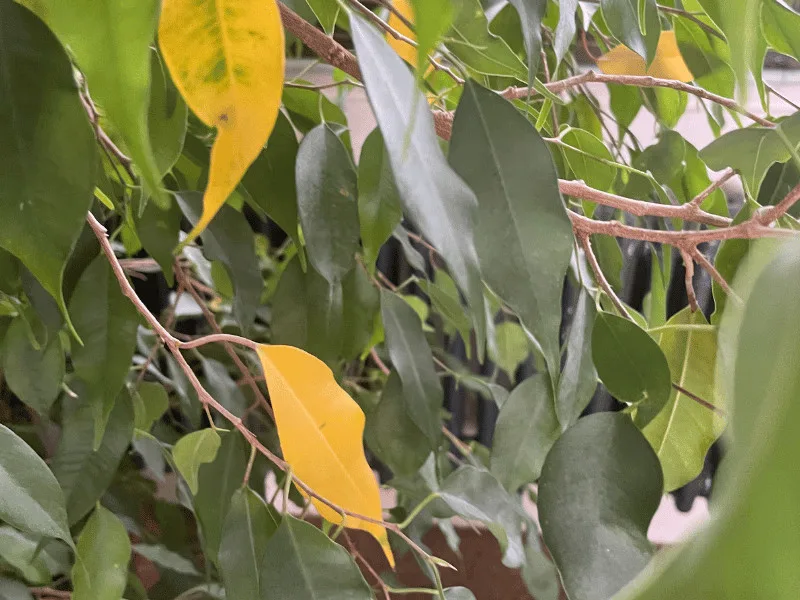
Plants show their unhappiness by developing yellow leaves. Yellowing leaves make the plant look unattractive. They are unsightly, and indoor and outdoor gardeners tend to remove them manually before they fall off.
Table of Contents

1. Yellow Leaves due to Moisture Stress
Moisture stress is the most common reason for yellow leaves on plants; either overwatering or under-watering can cause the green foliage of the plants to turn yellow.
So if your plant is suffering from yellow leaves, look out for your watering habits.
Watering is the most crucial element for plant care, but each plant has different watering requirements. Know your plant needs and water accordingly to avoid moisture stress.
Underwatering: Yellow, Dry, and Yurling Leaves
Examine the soil’s top 1-2 inches (2.5-5 cm); the plant is under-watered if it’s dry and crumbly. When there is a lack of water, the plant will shed some leaves to conserve moisture.
There is a possibility that you might be watering only the top of the soil. Water the plant slowly so that the roots can absorb the water.
If the soil is over-draining, add a mulch layer around the plant to retain the moisture.
Overwatering: yellow, drooping, and dull, lifeless leaves
Examine the top 1-2 inches of soil (2.5-5 cm); you overwater the plant if it feels very wet.
Overwatering can waterlog the soil. Without oxygen, roots start to die, and the plant starts yellowing.
Reduce the amount of water or water less frequently. You can also improve the soil drainage by using sand or replanting at a slightly raised location.
Make sure potted plant containers have holes at the bottom to allow excess water drainage. Remember that the plant needs less water in cold weather as the evaporation rate is low.
The simple rule for watering is to examine the soil before watering and water only when necessary. If the soil feels damp, skip the watering.
2. Light Issues
If you are sure you are watering the plant well, your plant might be starving for sunlight or scorching from excessive light. Not receiving enough light can also turn the leaves yellow.
Plants that get too little light start to yellow on the lower leaves, and eventually, the leaves start dropping.
A plant that is yellowing from a lack of light will typically be yellow on the side away from the light source.
Plants utilize sunlight to create chemical energy, but the lack of sunlight can limit the rate of photosynthesis.
In this case, the leaves look droopy and faded. For landscape plants, to check if your plant is receiving proper light, examine the lower leaves.
The plant is facing light deficiency if the lower leaves are pale yellow.
Reposition your plant in a new sunny location and see how it performs. Your plant might be located in a crowded area where. Trim the nearby plants to allow proper sunlight.
Different plants require different hours of direct sunlight for healthy growth. For your indoor plants in winter, you can get an artificial plant light to supply the light necessary for the plant.
While some plants are sun lovers and need direct sunlight, others require low to medium light every day. The extra light will scorch such species. Read the plant label carefully to understand the lighting needs.
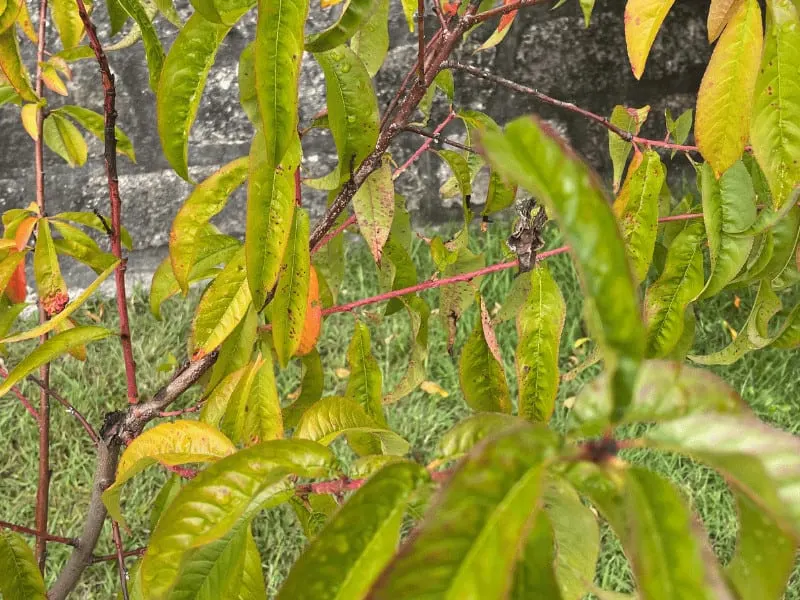
3. The Temperature is too High or too Low
If the whole plant is yellowing and the leaves have started dropping, your plant is unhappy with the temperature. It’s either too cold or too hot.
Most indoor plants are tropical; they prefer warm temperatures. If your indoor plant is near an air-conditioner, it may cause cold drafts. Cold drafts make your plant chilly and soggy.
Mist your indoor plants during cold drafts to increase humidity. During cold conditions, the chemical reactions are slowed, reducing chlorophyll production. As a result, the plant loses its green color.
Indoor plants can suffer from inconsistent temperatures within the house.
Avoid placing the indoor plants near drafty windows or close to heating/ air-conditioning sources. Temperature fluctuations or extreme temperatures can disturb the plants.
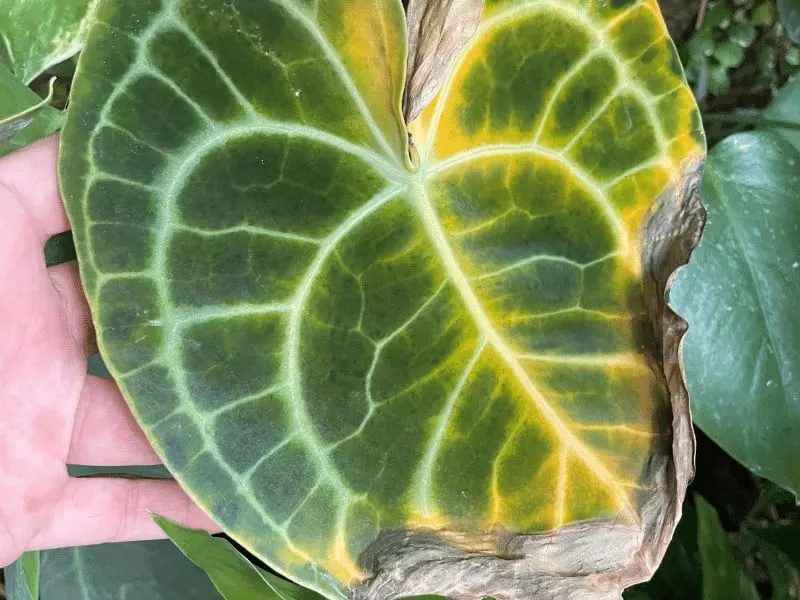
4. Nutrient Deficiencies
Nutrient requirements vary depending on the species.
Leaf deformities with discolored or yellowing veins, and tissue indicate your plant is suffering from nutrient deficiency.
Injured or weak root growth makes it difficult for the plant to absorb the nutrients. Either the nutrients in the soil are insufficient or unavailable due to high ph. You can also test the soil to check which nutrient is missing.
For plants growing in containers, limited space is available for the roots to grow and store moisture. If your indoor plant has started showing yellow leaves despite all the plant care, consider repotting the plant to a bigger container or try fertilizers.
Most plants need essential nutrients in the soil for their growth; the yellow pattern on the leaves can help you decide which vital nutrients are missing.
Following are some of the common nutrient deficiencies that cause yellow leaves on plants:
Nitrogen: Older leaves on your plant turn yellow, and the new leaves are very light green. Add organic compost or coffee grounds to the soil at the base of the plant or apply a balanced fertilizer.
Potassium deficiency: The old leaves’ edges, tips, and veins become yellow with brown spots.
Add citrus rinds or coverings to the base of the plants. Add compost enriched with fruit and vegetable waste or a potassium fertilizer.
Iron deficiency: When the leaves become yellow with small green veins and stunted growth. Check the pH of the soil and bring it below seven by adding sulfur. Reduce the amount of phosphorus in the soil.
Calcium deficiency: The leaves have yellow or brown spots surrounded by brown edges. Add lime to acidic soil, and use gypsum for alkaline soil.
Zinc deficiency: The leaves are discolored, and the tissue between veins is yellow while the veins are green. Spray the plant with kelp extract.
Magnesium deficiency: Yellowing of lower leaves between the veins. Add organic compost with magnesium, lime, or Epsom to the soil.
During the growing season primary source of nutrients are fertilizers; use the fertilizers at the labeled rate to avoid under or over-fertilizing.
You can use fertilizers or organic food for plants to overcome nutrient deficiencies. You can read more about soil nutrients and fertilizers in our extensive article.
5. Diseases
Another reason for yellow or discolored leaves is disease or fungus. It has a viral infection if your plant has blotchy leaves with yellow patches, deformed stems, and discolored flowers.
Some of the diseases are incurable and can spread to other nearby plants.
Therefore treat or dispose of the plant immediately. Don’t forget to wash and disinfect the tools before reusing them.
Yellow leaves on plants may be due to any of the following diseases:
Leaf spot: Many annual and perennial flowering plants are susceptible to bacterial leaf spot. The spots are brown or black, with dark rings around the spots.
Plants infected with leaf spots will have yellow leaves, and the leaves may drop. Most leaf-bearing plants are susceptible to this disease.
The fungus of the leaf spot can survive in plant debris and spread to other plants. Properly treat or dispose of the infected plant to control the spread of the disease.
Use a garden fungicide to treat the plant and change the pH balance to avoid infections. You can also use a tablespoon or two of baking soda and a teaspoon of mineral oil in a spray bottle of water.
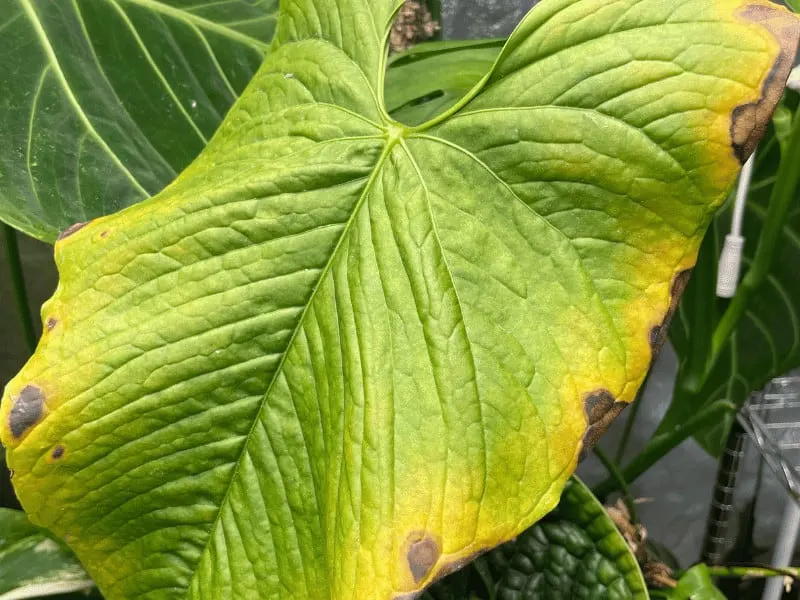
Black spot: It is an infectious fungal disease that resembles black splotches. It causes yellowing leaves, premature leaf drop, and a plant growth decline.
It occurs during moist and humid conditions and affects the new leaf tissues. Use a sulfur or copper fungicide to treat black spot and focus on the following:
- As the black spot thrives in wet conditions, keep the leaves dry by ensuring good air circulation and watering the plant at the base instead of the top or leaves.
- Keep the soil well-drained to discourage the growth of fungal diseases.
- Using organic compost will provide microorganisms activity to fight diseases and plant problems.
Powdery mildew: It is the most common plant disease. The gray or white matter on the leaves resembles dust or dirt.
It first appears on the plant’s lower leaves and can spread to the entire plant if left untreated.
The main symptoms are distorting leaves, buds, tips, or fruits, followed by yellowing leaves or tissue death.
You can use a garden fungicide when you first see the symptoms of powdery mildew and apply it again after 7 to 10 days to eliminate the disease.
Rust: There are more than 5000 species of rust that can infect plants. Fungal parasites cause rust, appearing as brownish-yellow or bright orange spots on the leaves.
The spots contain a powdery substance known as spores, which will spread the disease to other plants via air or water.
The most common symptoms are defoliation, reduced flower production, or dying branches. Immediately remove the infected parts of the plant and destroy them to control the spread.
To prevent rust, dust your plants with sulfur and maintain proper spacing to allow air circulation. You can also spray your plants with a rust fungicide.
Mosaic virus: It is a viral disease affecting various horticulture plants. The main symptoms of Mosaic virus are yellow or white spots/ streaks on the plant foliage, yellowing veins, and stunted growth.
This virus lives on perennial weeds and can be spread by garden pests such as aphids, leafhoppers, and whiteflies.
You should immediately destroy the infected plants and sterilize the garden tools to prevent the spread of the virus throughout your garden.
6. Pests can Lead to Yellow Leaves
The culprit for yellow leaves on plants could be the sucking insects that feed on the plant sap.
According to the University of Florida, if the plant’s health declines and leaves crinkles, you should check your plant for pests.
In addition to yellow leaves, tiny holes on the leaves indicate spider mites or pieces of leaf missing. You can control pest infections by using organic insecticides, horticulture, or neem oil.
Most pests thrive in dry conditions and keep the humidity level high. Check your plants for the following pests:
Spider mites: Suck chlorophyll from leaf tissues and create yellow or white spots known as stipples. They thrive in hot and dry conditions.
Spider mites are difficult to see with the naked eye, but the main symptoms are webbings on the leaves and discoloration, as well as yellow leaves on plants.
Inspect the top of the leaves for stippling and the underside for webbing. You can use a horticulture oil or insecticidal soap to eliminate the mite eggs.
Keep the plant clean and cool; maintain proper watering and fertilizing practice. Avoid over-fertilizing with nitrogen fertilizer, as it helps in mite growth.
Whiteflies: They infect several ornamental and vegetable plants. Whiteflies lay their eggs on new leaves. They feed on the leaves, which produce stippling of leaves, leading to yellow, dry, and distorted leaves.
Whiteflies secrete honeydew, which makes the leaves sticky with black mold. Heavy feeding by whiteflies can wilt and stunt the plant.
Spray an insecticidal soap on the underside of leaves and repeat the spraying if necessary.
Do not spray the plant in scorching weather. Horticulture oils are effective against all stages of this pest infection.
Aphids: are the most common pests for indoor and outdoor plants. Aphids are small yellow, red, or black colored sucking insects that feed on the sap of the plant.
If aphids have infested your plant, the growth stunts, and the leaves will curl, wilt or become yellow.
Pinch and prune infected parts of the plant. You can get rid of aphids using natural and organic control methods.
Use a bug blaster to remove the pests from the plant by using a strong stream of water. Apply Diatomaceous earth for long-term protection from aphids.
Read our aphid article for more tips and tricks to identify and eliminate aphids.
Scale insects: These insects attach themselves to the branches, leaves even fruits of the host plants. The most common host is ornamental shrubs, houseplants, backyard trees, or greenhouse plants.
When scale insects heavily infect the plant, it suffers from weak growth and chlorotic (yellow) leaves.
If the infection is left untreated, the plant will eventually die.
Prune and dispose of the infected branches and twigs. Horticulture oils are the most effective choice against larvae and even adult-scale insects, which are protected by their armor coverings.
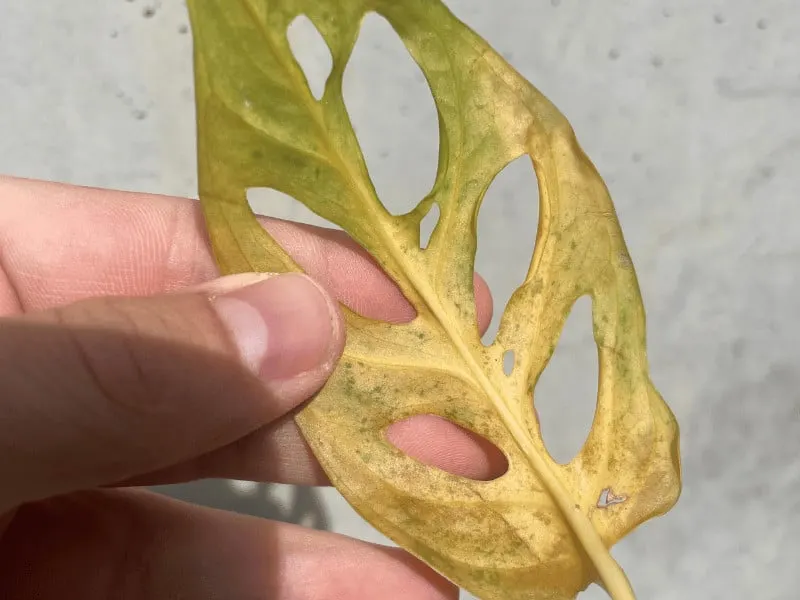
7. Transplant Shock
Transplant shock refers to the stresses experienced by a recently transplanted plant or shrub. It occurs when the plant has not established an extensive root system in its new location.
The plant is disturbed because the roots cannot absorb enough water for plant growth.
Leaf scorching is the first symptom of this condition; leaves and the tissue start yellowing and dry out. The leading causes are a weak root system, improper planting techniques, and watering.
The plants experiencing transplant shock are easily susceptible to diseases, insects, or weather. Such plants require extra care and watering to overcome this condition.
You can avoid transplant shock by hardening seedlings and gradually introducing them to the outdoor environment.
8. Chemical Burn
The wrong or excessive application of chemicals to plants causes pesticide burns. The main symptoms of pesticide burn are leaf spots, yellowing leaf, or tip burn.
Avoid spraying damaged or sensitive plants with pesticides or horticulture oils in hot or humid weather.
Spray the plants in dry and cool conditions when the temperature is below 29 degrees Celsius. Always read the label and instructions carefully about the applications or precautions to avoid pesticide burns.
9. Fertilizer Burn
Excessive fertilizing causes browning of leaf edges or leaf scorch. You might use too much fertilizer to encourage growth, which creates a toxic environment and burns the leaves.
The salts in the fertilizer extract the moisture from the root tissues leading to wilting, yellowing, and stunting. In hot weather, over-fertilizing can severely damage the roots of the plant.
Fertilizer burns can be avoided using a slow-release fertilizer or adding 1-2 inches of compost. Look for plant food with the required nutrient and follow the recommended feeding rate to prevent fertilizer burn.
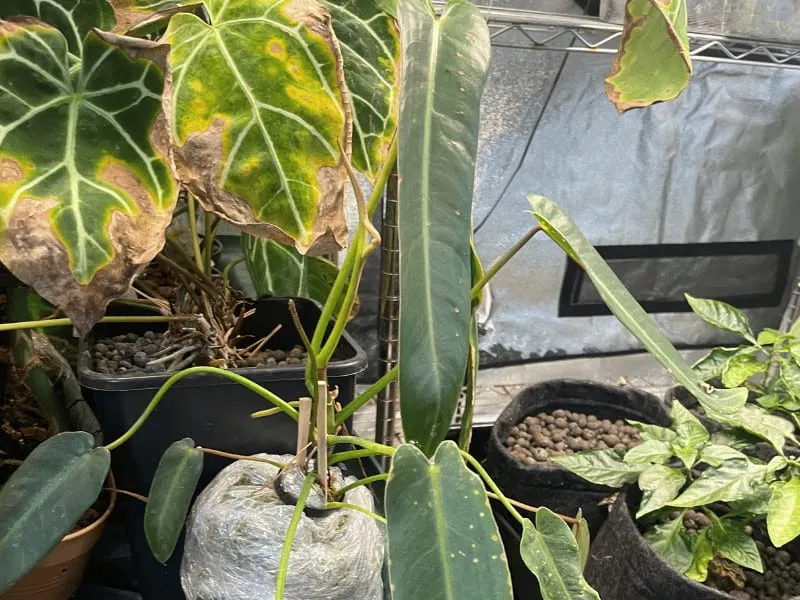
10. Yellow leaves due to Aging
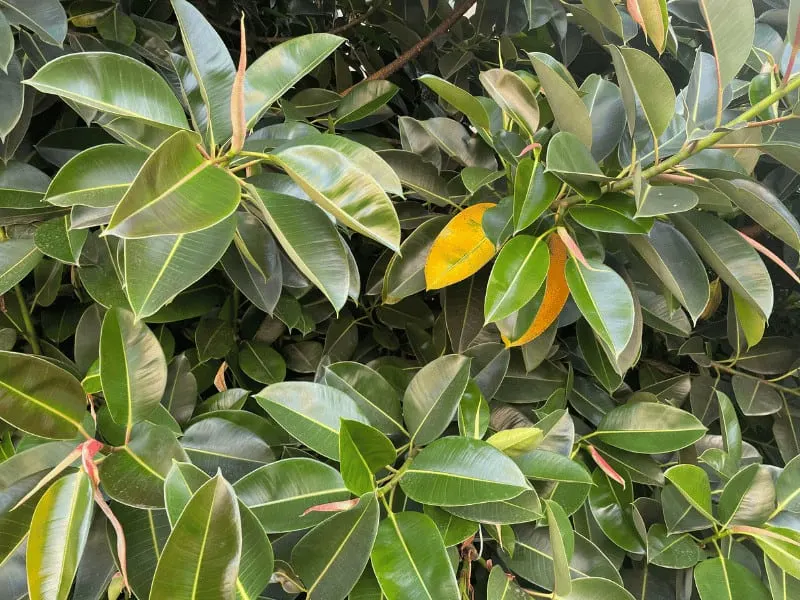
Yellow leaves on plants don’t always mean the plant is sick. If the plant is healthy and growing, but you notice some yellow leaves on the bottom of the plant, your plant is probably aging.
As plants age, the bottom (most mature) leaves will turn yellow and fall off to encourage new growth. It is a natural process, and there is nothing to worry about.
The old leaves will die off, and new ones will come as the plant grows.
You can differentiate natural aging from other reasons by examining the plant is rate of yellowing.
If one or two leaves are yellowing slowly and steadily, your plant is experiencing the natural leaf-shedding process. Aging is a healthy part of the plant life cycle.
FAQ
Why are the leaves of my succulent turning yellow?
Succulents have thick and fleshy leaves to help store water. But overwatering succulents causes edema. In this condition, the leaf cells swell and break.
You will notice brown growth on the leaves and yellowing foliage. Watch out for your watering habits during winter; only water if the top of the soil is dry.
You can also replant the succulent in a fast-draining soil mix.
How can I test the garden soil for nutrient deficiencies?
You can take soil samples from various areas in your garden to a local lab or gardening center for soil testing. The test will provide the pH level and nutrient deficiencies of the soil.
Testing your garden soil will also help you measure the health and fertility of the soil.
The soil test data can help you fix nutrient issues, choose the right fertilizers, and inform you about any soil problems specific to your geographic region.
How can winter dormancy cause yellow leaves on plants?
In the growing season, plants use photosynthesis to convert carbon dioxide, water, and other salts to carbohydrates and conserve energy.
Then in winter, these are used by the plant roots to supply the nutrients for the plant. Removing the chlorophyll will cause the leaves to become yellow, orange, or red.
The plant is no longer growing; it focuses on survival by going dormant during winter.
Yellow foliage indicates plant problem; that is sometimes serious and sometimes temporary.
In most cases, you can fix the yellow leaves on plants by changing the plant care routine. It is essential to familiarize yourself with plant-specific needs for indoor and outdoor plants.
Any change in the color of leaves indicates nutrients or environmental problems. Remove the damaged leaves to help the plant direct its energy towards new healthy growth.
Properly treating your plant can help you regain the lush green foliage.
Conclusion
Yellow leaves on plants can stress plant owners out as it often indicates something is wrong. The trick part is that it is not always sure what is wrong.
From over- to underwatering to plant pests, there can be many reasons why leaves on plants turn yellow. Or it might just be old leaves, and it can be completely natural.
I hope this extensive in-depth guide about yellow leaves on plants was helpful.
There are reasons such as root rot that might cause leaves to yellow and be serious. There might be other reasons such as aging leaves and there is nothing you have to do about it.

Daniel has been a plant enthusiast for over 20 years. He owns hundreds of houseplants and prepares for the chili growing seasons yearly with great anticipation. His favorite plants are plant species in the Araceae family, such as Monstera, Philodendron, and Anthurium. He also loves gardening and is growing hot peppers, tomatoes, and many more vegetables.

